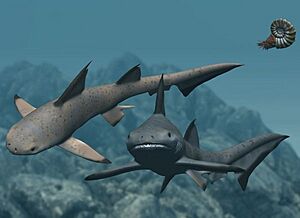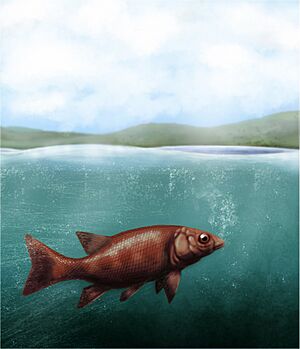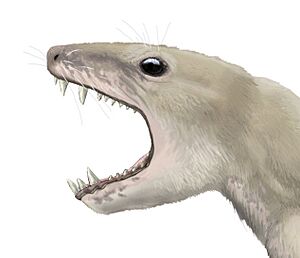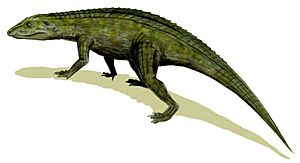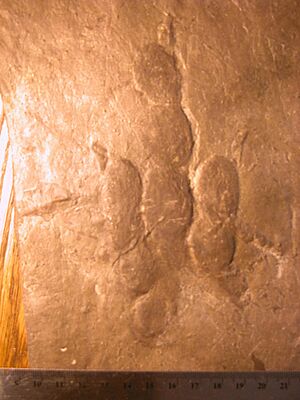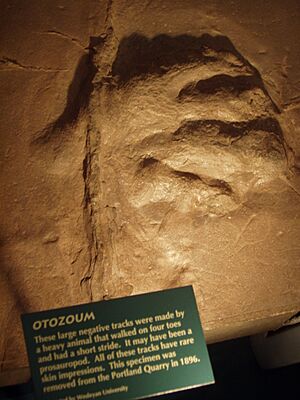Quick facts for kids McCoy Brook Formation
Stratigraphic range: Hettangian-Sinemurian |
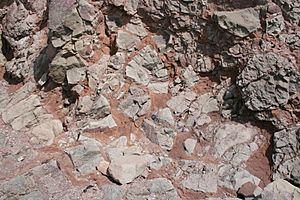
Breccia in the McCoy Brook Formation (Jurassic), Wasson's Bluff, Nova Scotia.
|
| Type |
Geological formation |
| Unit of |
Newark Supergroup
Meriden Group |
| Sub-units |
Scots Bay Member |
| Underlies |
Erosional top |
| Overlies |
North Mountain Basalt |
| Thickness |
more than 230 m (750 ft) |
| Location |
| Coordinates |
45°24′N 64°12′W / 45.4°N 64.2°W / 45.4; -64.2 |
| Approximate paleocoordinates |
27°24′N 13°18′W / 27.4°N 13.3°W / 27.4; -13.3 |
| Region |
 Nova Scotia Nova Scotia |
| Country |
 Canada Canada |
| Extent |
Bay of Fundy |
| Type section |
| Named for |
McCoy Brook, Nova Scotia |
The McCoy Brook Formation is a special type of rock layer. It formed about 200 to 190 million years ago. This was during the early Jurassic period, in stages called Hettangian and Sinemurian. You can find these rocks in places around the Bay of Fundy in Nova Scotia, Canada.
How Old is the McCoy Brook Formation?
The McCoy Brook Formation sits on top of another rock layer called the North Mountain Basalt. This basalt is a type of volcanic rock. It formed when lava flowed out during the time of the Triassic–Jurassic boundary. The McCoy Brook Formation started forming very soon after this lava cooled, probably within 100,000 to 200,000 years.
Scots Bay Member
Inside the McCoy Brook Formation, there's a thinner section called the Scots Bay Member. It's only about 9 meters (30 feet) thick. This part is made of sediments that settled in ancient lakes. You can find it in six small areas around Scots Bay. These areas are on the west side of the Blomidon Peninsula. It was once thought to be a separate formation, but now scientists know it's part of the McCoy Brook Formation.
Amazing Fossils Found Here
The McCoy Brook Formation is famous for the many fossils it holds. These fossils tell us about the animals that lived here millions of years ago.
Ancient Sharks
|
|
|
Color key
|
|
Notes
Uncertain or tentative taxa are in small text; crossed out taxa are discredited. |
| Sharks |
| Name |
Notes |
Images |
| cf. Hybodus |
This was a type of ancient shark called a hybodont. Its fossils are found in old lake limestone and basalt rocks. |
|
Ray-finned Fish
| Ray-finned Fish |
| Name |
Notes |
Images |
| ?Redfieldiid |
We find scales and skull bones from this fish. They are in lake limestone and basalt rocks. |
|
| aff. Semionotus sp. |
This fish lived in ancient lakes. Its fossils are found in limestone, basalt, and mudstone. |
|
Synapsids (Early Mammal Relatives)
| Synapsids |
| Name |
Notes |
| Pachygenelus |
This was a cynodont, an animal related to early mammals. It lived near rivers and lakes. |
|
| Oligokyphus |
Another type of cynodont. A jawbone fragment of this animal was found in the Scots Bay Member. |
|
| Tritylodontidae |
This cynodont was also found in the Scots Bay Member. Only a right arm bone (humerus) has been found. |
|
| Cynodontia |
Other parts of cynodonts, like a lower arm bone (ulna) and a hip bone (ischium), have been found here. |
|
Sphenodonts (Lizard-like Reptiles)
| Sphenodonts |
| Name |
Notes |
| Clevosaurus |
C. bairdi |
This was a small, lizard-like reptile. Its skull and body bones were found at Wasson Bluff. It lived in areas with rivers, lakes, and volcanic rock. |
Crocodyliforms (Ancient Crocodile Relatives)
| Protosuchidae |
| Genus |
Notes |
Images |
| Protosuchus |
P. micmac |
This was an early crocodile relative. Parts of its jaw and skull were found at Wasson Bluff. It lived in areas with rivers, lakes, and volcanic rock. |
|
| Sphenosuchid |
Another type of early crocodile relative. Only an upper jaw bone (maxilla) has been found. |
|
Dinosaurs!
Yes, dinosaurs lived here too!
Ornithischian Dinosaurs
| Ornithischian Dinosaurs |
| Genus |
Notes |
| Ornithischia indet. |
We know these plant-eating dinosaurs were here from their teeth. They lived in areas with rivers, lakes, and volcanic rock. |
Sauropodomorph Dinosaurs
| Sauropodomorph Dinosaurs |
| Genus |
Notes |
Images |
| Fendusaurus |
F. eldoni |
Several partial skeletons of this large, long-necked dinosaur have been found. It was once thought to be a different dinosaur, Ammosaurus, but it's actually a new type! It lived in areas with rivers, lakes, and volcanic rock. |
|
|
|
|
Color key
|
|
Notes
Uncertain or tentative taxa are in small text; crossed out taxa are discredited. |
| Fossil Footprints |
| Genus |
Notes |
Images |
| Anomoepus |
A. scambus |
These are fossil footprints found in rocks that formed from rivers and lakes. |
|
| Batrachopus sp. |
More fossil footprints found in river and lake sediments. |
|
| Grallator sp. |
These footprints are also found in river and lake sediments. |
|
| Otozoum |
O. moodi |
These large footprints are found in river and lake sediments. |
|
See also
 In Spanish: Formación McCoy Brook para niños
In Spanish: Formación McCoy Brook para niños

 In Spanish: Formación McCoy Brook para niños
In Spanish: Formación McCoy Brook para niños

